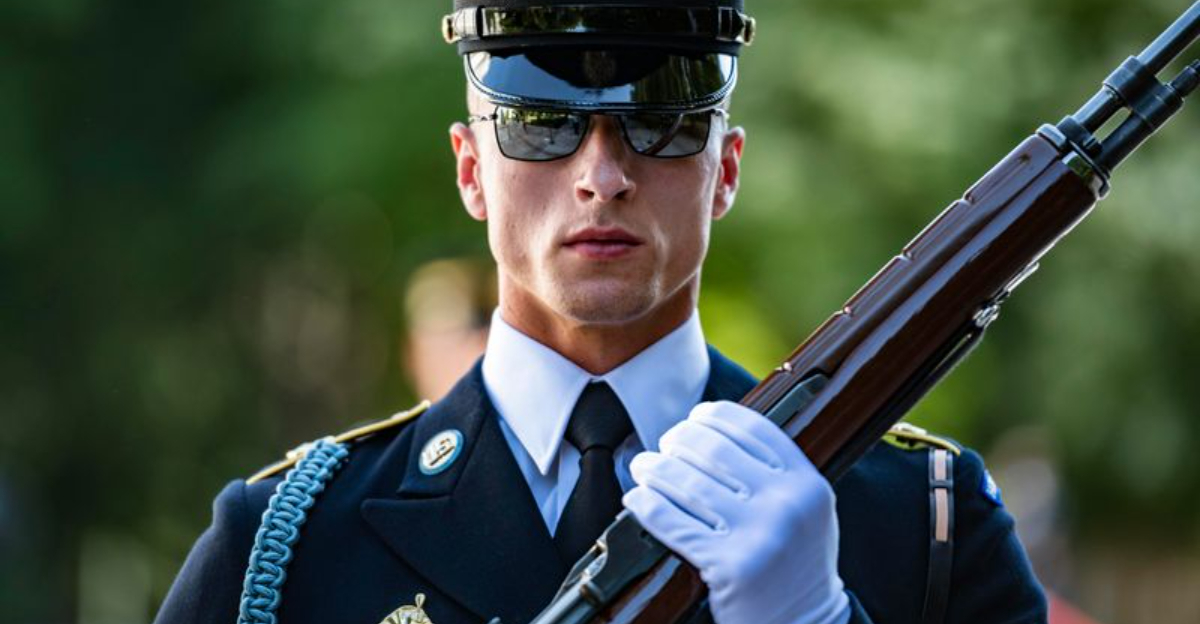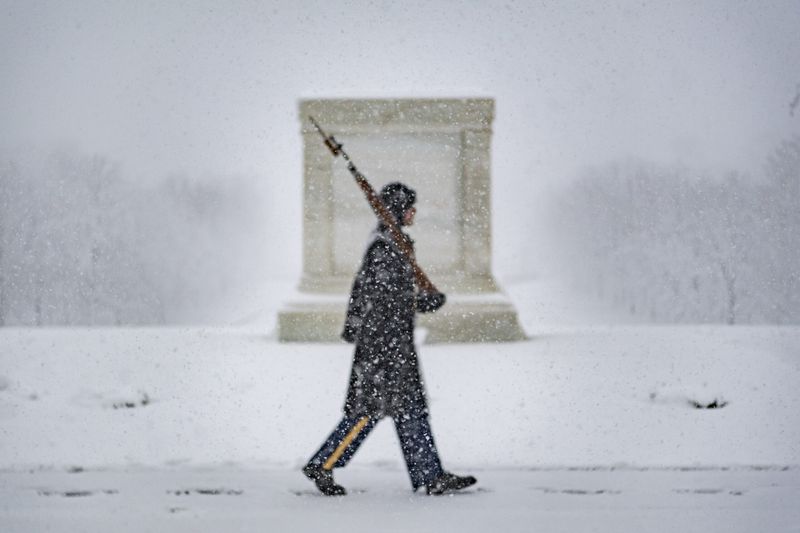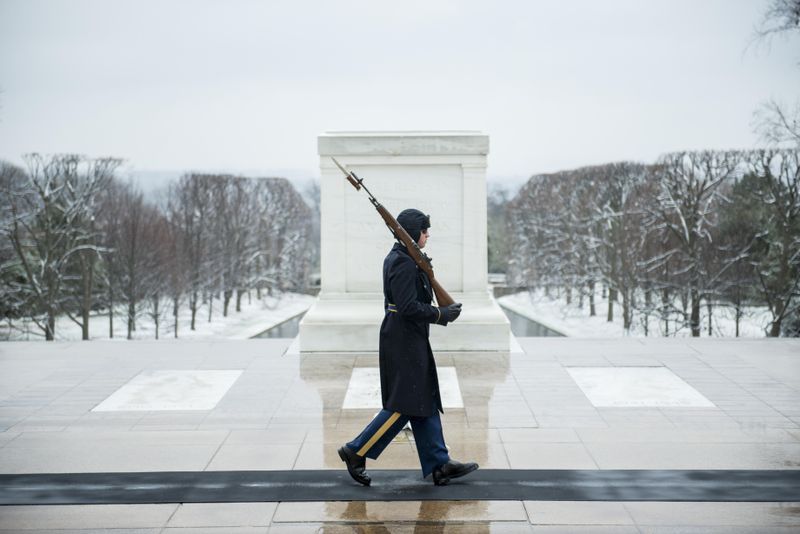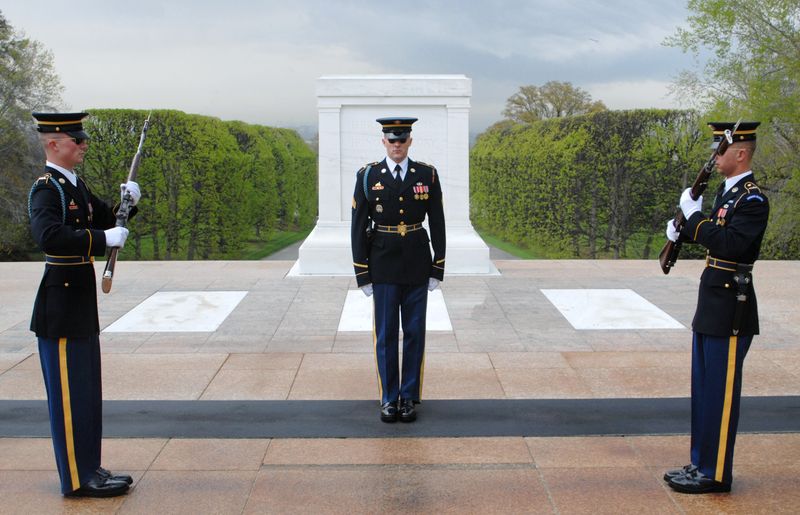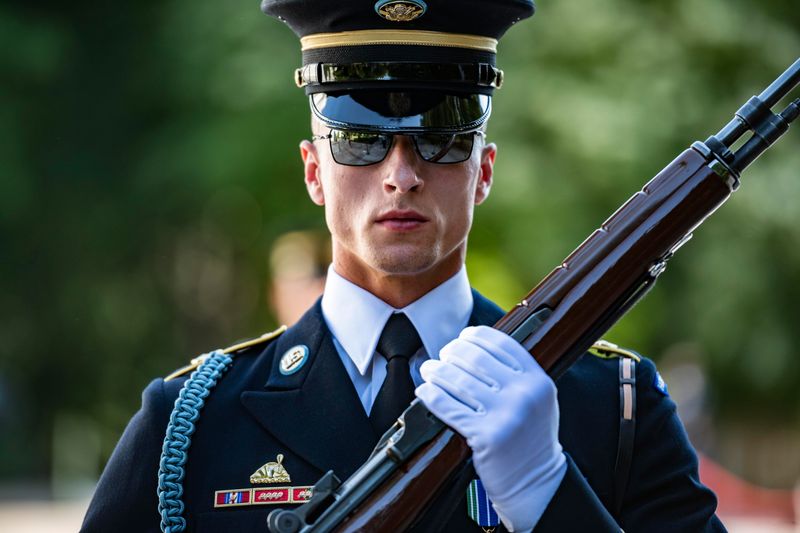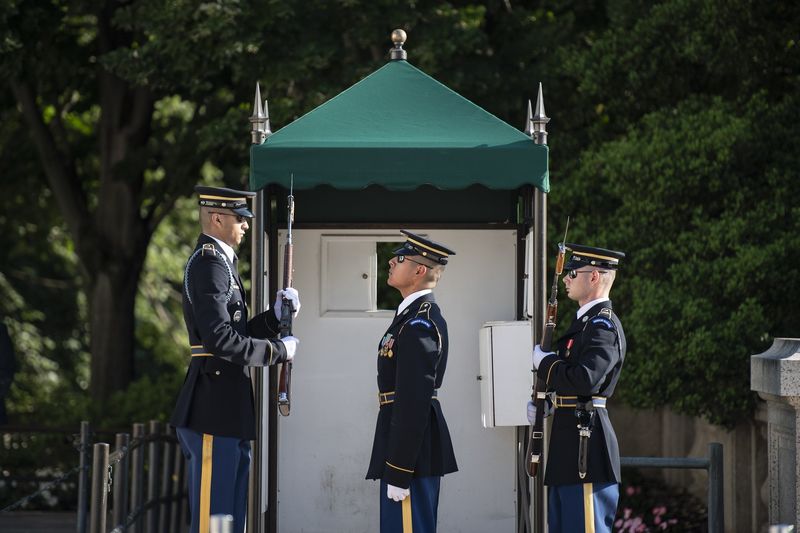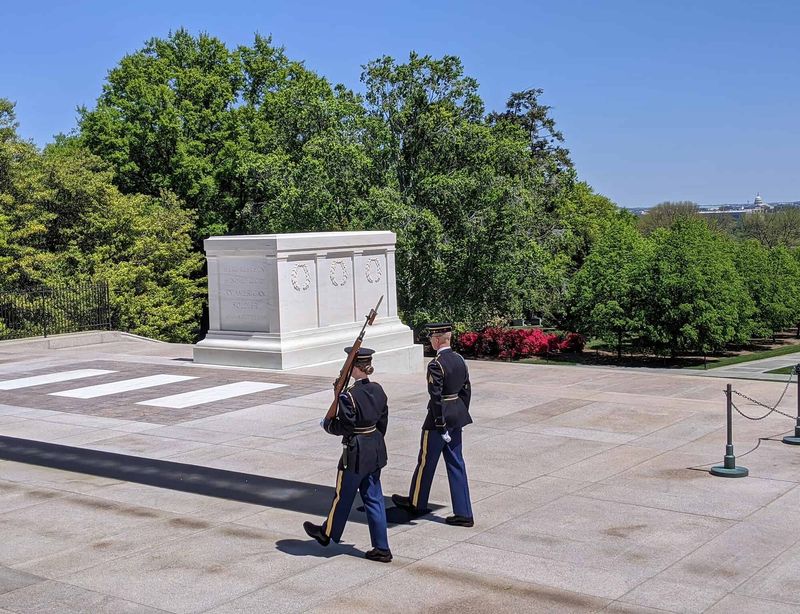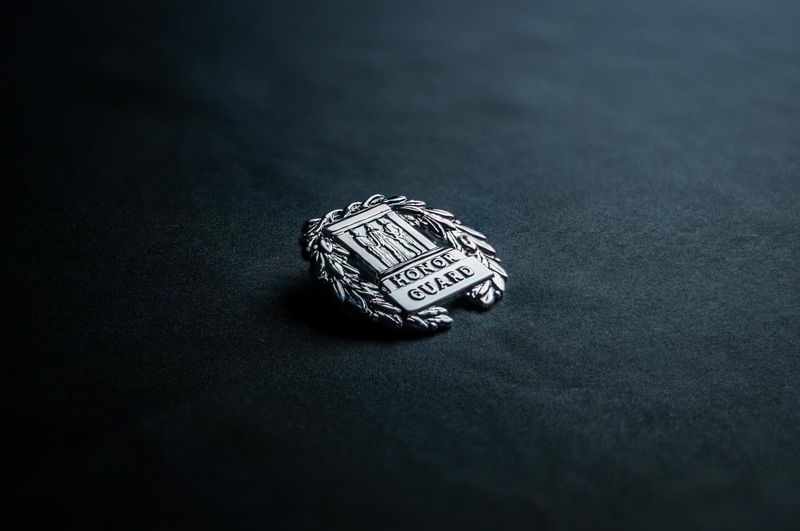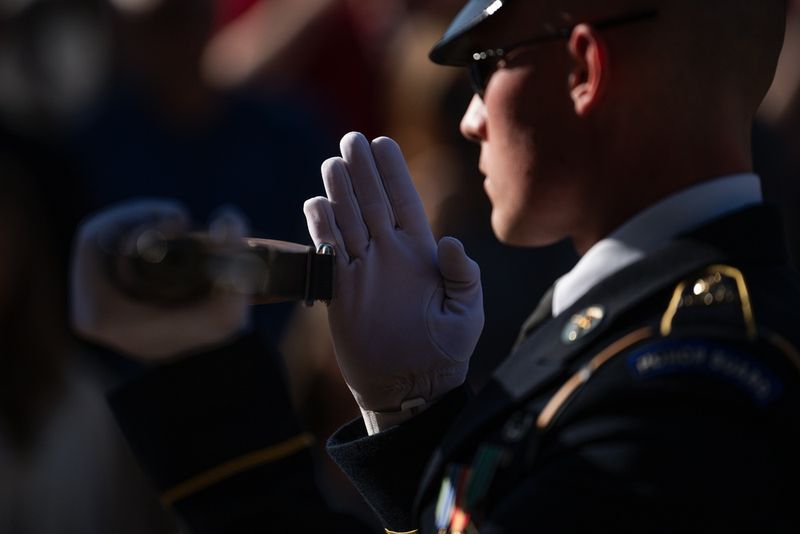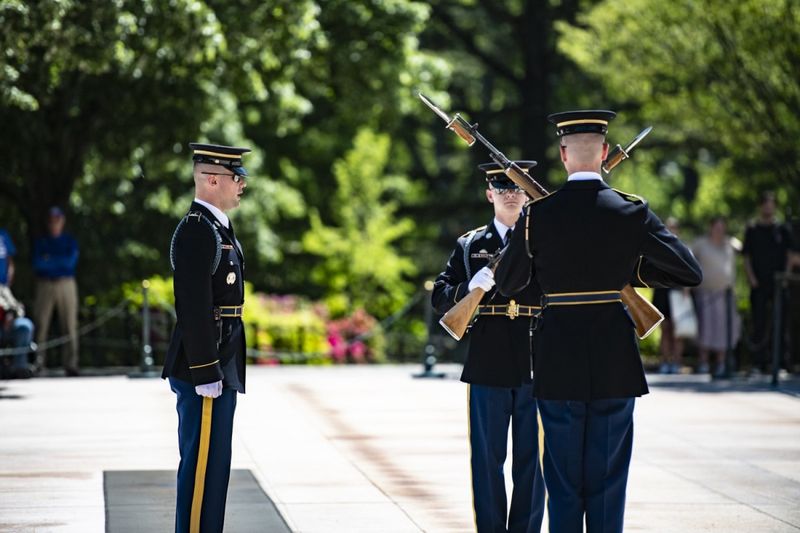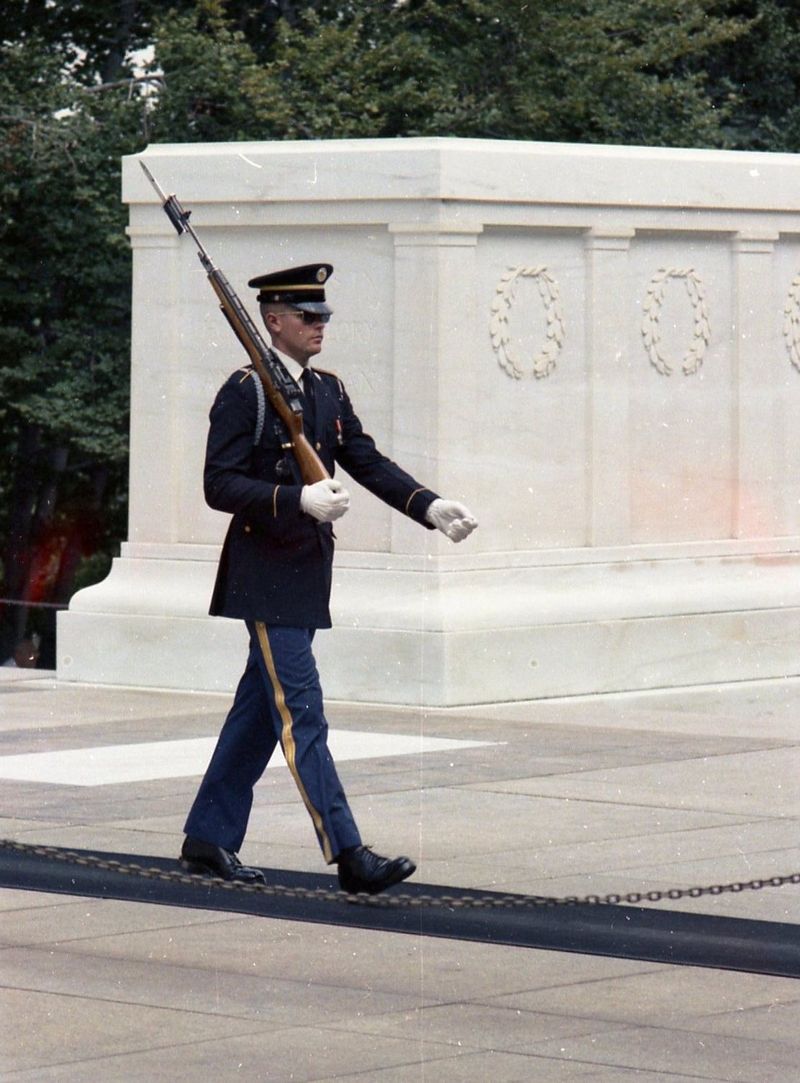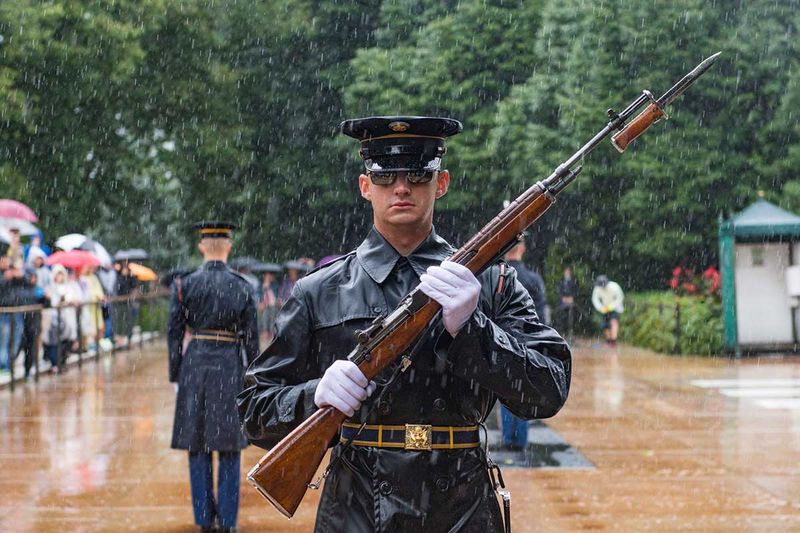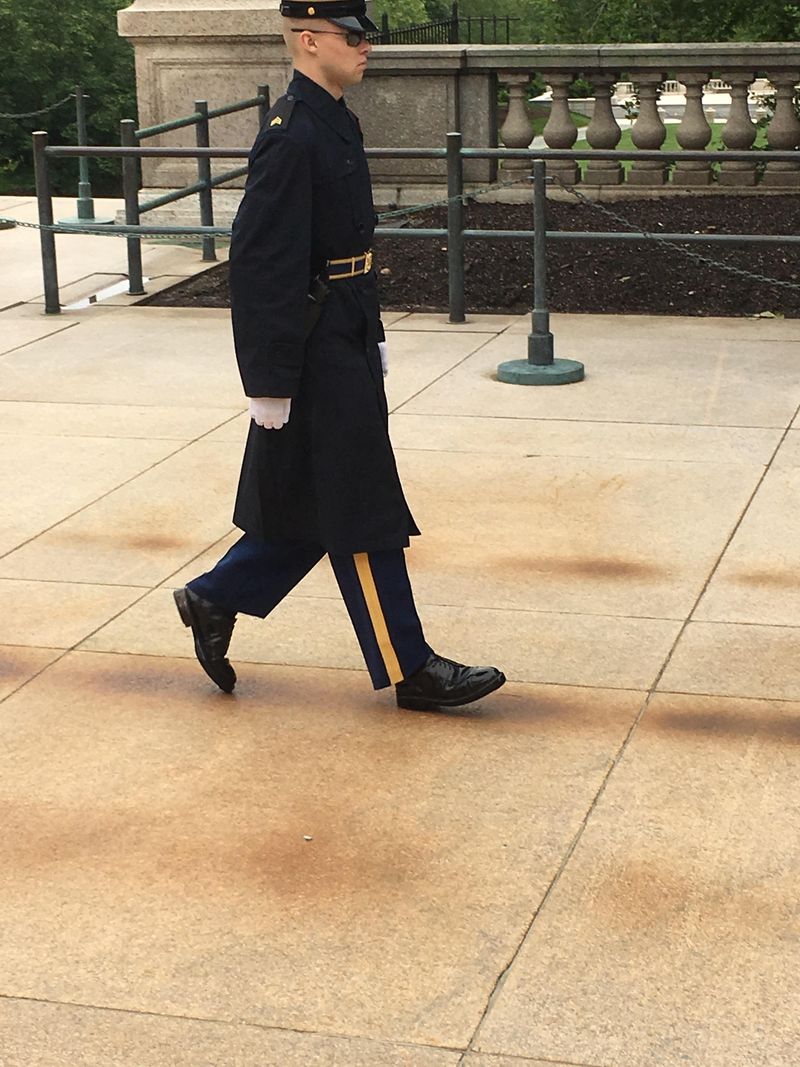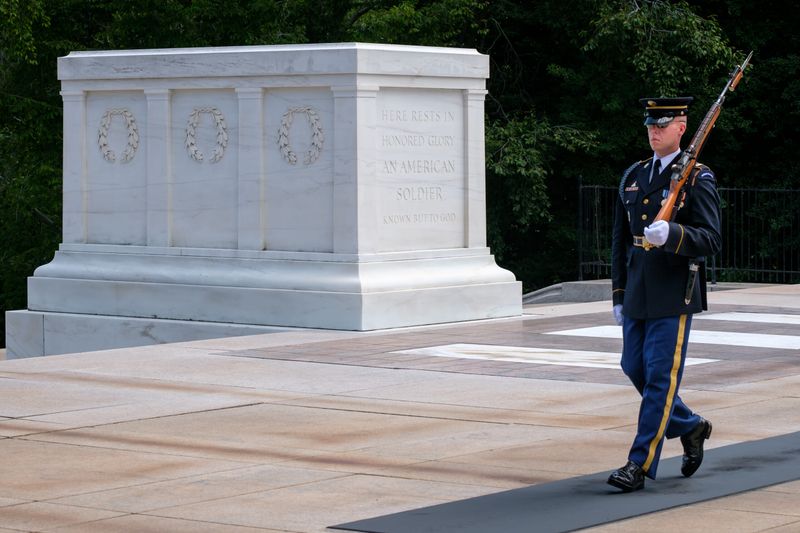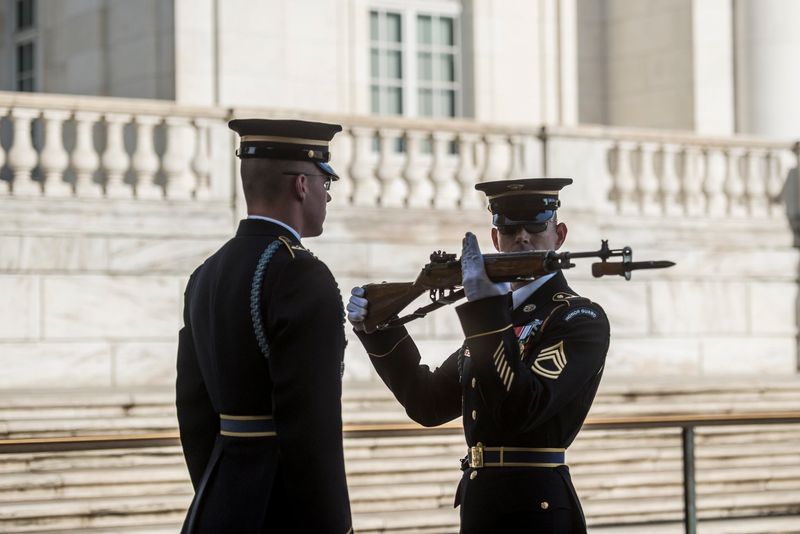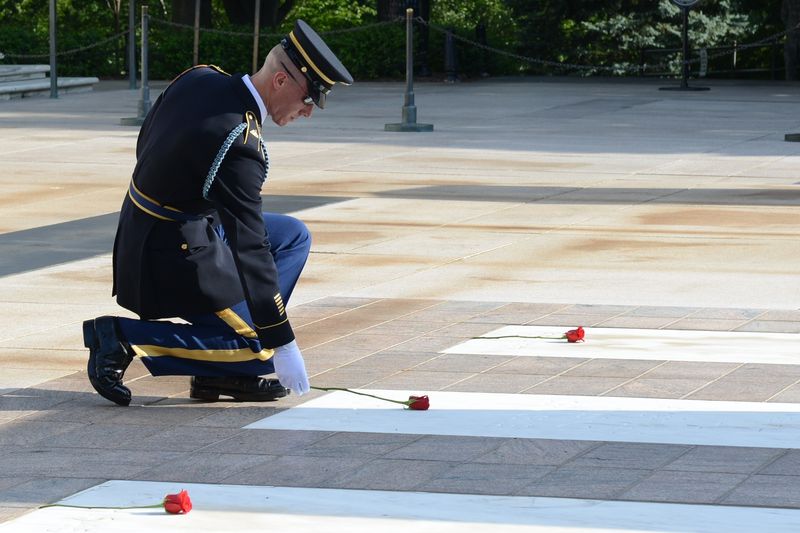The Tomb of the Unknown Soldier at Arlington National Cemetery stands as a solemn tribute to unidentified American service members who made the ultimate sacrifice.
The elite sentinels who guard this sacred monument follow an extraordinarily precise set of rules and traditions.
These dedicated soldiers from the 3rd U.S. Infantry Regiment uphold standards of discipline and reverence that honor the fallen through their unwavering commitment and precision.
1. 24/7 Guard Duty, Rain or Shine
Since 1937, the Tomb has never been left unguarded—not even for a single moment. Through blizzards, hurricanes, and scorching heat waves, the watch continues without interruption.
During Hurricane Isabel in 2003, guards refused to abandon their post despite the danger. When offered permission to stand down during extreme weather, the Tomb Guard Platoon Commander reportedly answered: “No way, Sir!”
This perpetual vigil represents America’s eternal gratitude to those who died nameless in service to their country. The unbroken chain of guardianship has continued for over 80 years—more than 30,000 consecutive days.
2. The 21-Step March
Each guard executes precisely 21 steps along the black mat before the Tomb. This deliberate number symbolizes the 21-gun salute—the highest military honor bestowed upon dignitaries and fallen warriors.
After completing these steps, the sentinel pauses for exactly 21 seconds, facing the Tomb with unwavering attention. The rifle is then ceremoniously shifted to the opposite shoulder, placing the weapon between the Tomb and the guard in a protective stance.
Every movement is executed with mechanical precision. The ritual creates a hypnotic rhythm that emphasizes the solemnity of the guard’s sacred duty to the unknown heroes resting within.
3. No Rank on Uniform While on Duty
In a profound gesture of respect, guards remove all rank insignia from their uniforms while serving at the Tomb. This tradition ensures no sentinel ever outranks the Unknown Soldiers they protect—service members who represent all ranks from private to general.
The absence of rank creates equality between the living guards and the fallen unknown. Their immaculate uniforms still display decorations and unit patches, but the shoulders remain bare where rank would normally appear.
This humble act acknowledges that in death and sacrifice, military hierarchy dissolves. The Unknown Soldiers transcend ordinary status to become symbols of all who gave their lives in service.
4. Guards Are Part of The Old Guard
Only soldiers from the prestigious 3rd U.S. Infantry Regiment—known as “The Old Guard”—are eligible to volunteer as Tomb Sentinels. This historic regiment, established in 1784, is the oldest active infantry unit in the Army.
Before even applying for Tomb Guard training, candidates must serve with distinction within The Old Guard. Many spend years building impeccable service records to earn consideration.
The regiment performs numerous ceremonial duties beyond guarding the Tomb, including presidential inaugurations and state funerals. Their nickname, “The Old Guard,” reflects their status as the official escort to the President and their role as guardians of America’s most sacred military traditions.
5. Height & Appearance Requirements
The physical standards for Tomb Guards reflect the ceremonial gravity of their role. Male sentinels must stand between 5’10” and 6’4″, while female guards must measure between 5’8″ and 6’2″—creating visual uniformity during rotations.
Beyond height, appearance standards are exacting. Hair must be immaculately groomed, with male guards maintaining fresh haircuts every week. Uniforms must fit perfectly, with measurements precise to the fraction of an inch.
Weight proportional to height is strictly enforced. Guards spend countless hours perfecting their appearance, from spit-shining shoes to ensuring every brass button gleams. These standards aren’t just about looks—they demonstrate the discipline and attention to detail honoring the Unknowns.
6. Months of Grueling Training
The journey to becoming a Tomb Guard begins with a two-week trial period that eliminates most candidates immediately. Those who survive face an intensive training regimen lasting 9-12 months for full qualification.
Trainees memorize 35 pages of Arlington Cemetery history verbatim, including the locations of nearly 300 veterans’ graves. Physical training is relentless—guards practice the precise 21-step march for hours daily until every movement becomes second nature.
Uniform preparation becomes an art form, with guards spending up to eight hours perfecting their appearance before a single hour of duty. The dropout rate exceeds 90%, making this one of the military’s most demanding specializations despite involving no combat.
7. Tomb Guard Identification Badge
The Tomb Guard Identification Badge ranks among the rarest military decorations in America. Since its creation in 1958, fewer than 700 have been awarded—making it the second-rarest badge in the military after the Astronaut Badge.
Guards must complete at least nine months of flawless service to earn this honor. Unlike most military badges, this one can be permanently revoked even decades after service if a former guard brings dishonor to the Tomb through criminal activity or public disgrace.
The badge depicts Inverted Grecian torches representing eternal life, with the figures of Peace, Victory, and Valor surrounding the Tomb. Guards wear it proudly on their right breast pocket—a symbol of extraordinary dedication.
8. Zero Tolerance for Mistakes
Perfection isn’t just expected—it’s demanded. During inspection, superiors scrutinize uniforms with white gloves, searching for a single loose thread or microscopic dust particle. Finding even one flaw can result in hours of remedial work.
Guards who make visible errors during their walk face immediate correction. A slight misstep, improper weapon handling, or deviation from timing standards requires the guard to repeat training exercises for days afterward.
The standards seem impossibly high to outsiders, but guards embrace this pursuit of perfection. Each flawlessly executed shift honors the unnamed heroes who never returned home to receive recognition. The zero-tolerance policy ensures the ceremonial guard remains worthy of its sacred duty.
9. Strict Personal Conduct—Even Off Duty
A Tomb Guard’s commitment extends far beyond their shifts at Arlington. They sign a pledge to maintain exemplary behavior throughout their lives—both in and out of uniform.
Guards avoid alcohol in public, refrain from swearing, and maintain composure in all circumstances. Many don’t even publicly identify themselves as Tomb Guards to avoid drawing personal attention to their service.
This lifelong code of conduct reflects the belief that representing the Unknown Soldiers is not just an assignment but a sacred trust. Former guards often report that these standards become so ingrained that they maintain them decades after their service concludes—a permanent transformation shaped by their time honoring America’s fallen heroes.
10. No Public Display of Emotion
Maintaining absolute composure regardless of circumstances is non-negotiable for Tomb Guards. Through distractions, provocations, or extreme weather, their expressions remain stoically focused.
Visitors occasionally attempt to provoke reactions—from making jokes to creating loud disturbances. Guards are trained to remain impassive, though they will interrupt their march to address disrespectful behavior when necessary.
This emotional discipline serves multiple purposes. It honors the solemn nature of the memorial, demonstrates military bearing at its highest level, and allows guards to endure the psychological weight of their duty. Even at funerals for fellow guards, Tomb Sentinels maintain their composure—saving their grief for private moments away from their post.
11. Sunglasses Required (Daytime Duty)
The distinctive dark sunglasses worn by daytime Tomb Guards serve practical purposes beyond their imposing appearance. The brilliant white marble of the Tomb creates intense glare that can impair vision and make precision movements difficult.
These are not ordinary sunglasses. Guards wear specifically approved military-issue eyewear with precise specifications for lens darkness and frame style.
The glasses also provide a psychological barrier, helping guards maintain their stoic demeanor by concealing their eyes from onlookers. During night shifts, guards remove the sunglasses—one of the few modifications to their appearance between day and night duty. This practical adaptation ensures guards can maintain their vigilant watch regardless of lighting conditions.
12. Modified Footwear
The distinctive “click” heard during the Tomb Guard’s march comes from specially modified shoes. Metal plates—similar to those on tap dance shoes—are secured to both the heel and sole, creating the ceremonial cadence that echoes across Arlington.
Guards spend countless hours building up layers of polish on these shoes. The meticulous process involves applying polish, burning it with a lighter, and buffing until the surface resembles black glass.
These modifications serve practical purposes beyond tradition. The metal plates provide stability during the precise movements of the guard change. The extra-thick soles also help guards maintain proper posture during long shifts standing on marble surfaces, reducing fatigue while creating the signature sound that has become synonymous with the solemn ceremony.
13. No Talking, Laughing, or Disrespect by Visitors
While visitors number in the millions annually, the atmosphere at the Tomb remains reverently quiet. Guards will immediately address disruptive behavior by halting their march and confronting the source of disrespect.
The guard steps off the mat, faces the offender, and announces: “It is requested that all visitors maintain an atmosphere of silence and respect at all times.” This rare break from the ceremonial routine makes a powerful impression on witnesses.
Most visitors are unaware that Tomb Guards have full authority to remove anyone from the site. The cemetery is federal property, and disrespecting it carries potential legal consequences. This rule ensures the Unknown Soldiers receive the same dignified treatment in death that their identified comrades receive at military funerals.
14. Switching Shoulders = Symbol of Protection
The ceremonial rifle carried by Tomb Guards never points toward the Tomb itself. After completing the 21-step march and facing about, guards deliberately transfer their weapon to the opposite shoulder—placing it between themselves and the public.
This symbolic gesture positions the guard as a protective barrier between the world and the hallowed remains. The rifle is always carried on the shoulder facing the visitors, never pointing toward the sacred monument.
The M14 rifles carried by the sentinels, while meticulously maintained, contain no ammunition. Their purpose is purely ceremonial, representing the guard’s role as defender of the Tomb. This ritual of switching shoulders has remained unchanged for generations, connecting today’s guards with those who came before them.
15. Final Walk Tradition
When a Tomb Guard completes their service, they perform one last ceremonial walk unlike any other. This deeply personal “final walk” marks the conclusion of their sacred duty to the Unknown Soldiers.
During this solemn farewell, the departing guard places a single red rose at each of the three crypts within the Tomb complex. This gesture of respect and farewell creates a poignant visual—vibrant roses against white marble—symbolizing the blood sacrificed by those who rest there.
Many guards describe this moment as emotionally overwhelming after months or years of maintaining rigid composure. For most, it represents the only time they publicly display emotion at the Tomb, as they bid farewell to the unnamed heroes they’ve honored through their service.
